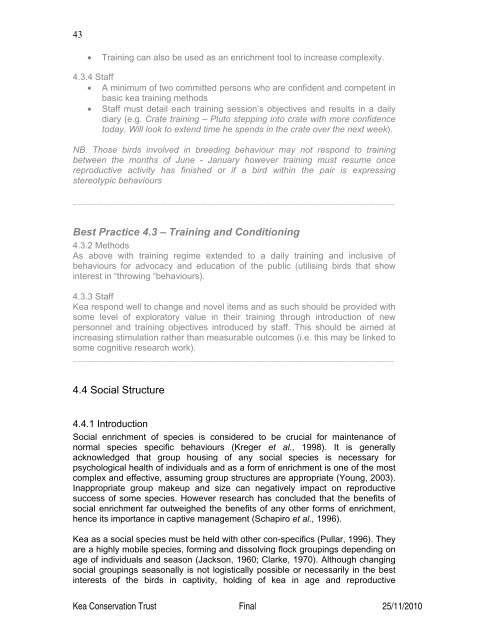(Nestor notabilis) Husbandry Manual - Kea Conservation Trust
(Nestor notabilis) Husbandry Manual - Kea Conservation Trust
(Nestor notabilis) Husbandry Manual - Kea Conservation Trust
You also want an ePaper? Increase the reach of your titles
YUMPU automatically turns print PDFs into web optimized ePapers that Google loves.
43<br />
• Training can also be used as an enrichment tool to increase complexity.<br />
4.3.4 Staff<br />
• A minimum of two committed persons who are confident and competent in<br />
basic kea training methods<br />
• Staff must detail each training session’s objectives and results in a daily<br />
diary (e.g. Crate training – Pluto stepping into crate with more confidence<br />
today. Will look to extend time he spends in the crate over the next week).<br />
NB. Those birds involved in breeding behaviour may not respond to training<br />
between the months of June - January however training must resume once<br />
reproductive activity has finished or if a bird within the pair is expressing<br />
stereotypic behaviours<br />
_________________________________________________________________<br />
Best Practice 4.3 – Training and Conditioning<br />
4.3.2 Methods<br />
As above with training regime extended to a daily training and inclusive of<br />
behaviours for advocacy and education of the public (utilising birds that show<br />
interest in “throwing “behaviours).<br />
4.3.3 Staff<br />
<strong>Kea</strong> respond well to change and novel items and as such should be provided with<br />
some level of exploratory value in their training through introduction of new<br />
personnel and training objectives introduced by staff. This should be aimed at<br />
increasing stimulation rather than measurable outcomes (i.e. this may be linked to<br />
some cognitive research work).<br />
_________________________________________________________________<br />
4.4 Social Structure<br />
4.4.1 Introduction<br />
Social enrichment of species is considered to be crucial for maintenance of<br />
normal species specific behaviours (Kreger et al., 1998). It is generally<br />
acknowledged that group housing of any social species is necessary for<br />
psychological health of individuals and as a form of enrichment is one of the most<br />
complex and effective, assuming group structures are appropriate (Young, 2003).<br />
Inappropriate group makeup and size can negatively impact on reproductive<br />
success of some species. However research has concluded that the benefits of<br />
social enrichment far outweighed the benefits of any other forms of enrichment,<br />
hence its importance in captive management (Schapiro et al., 1996).<br />
<strong>Kea</strong> as a social species must be held with other con-specifics (Pullar, 1996). They<br />
are a highly mobile species, forming and dissolving flock groupings depending on<br />
age of individuals and season (Jackson, 1960; Clarke, 1970). Although changing<br />
social groupings seasonally is not logistically possible or necessarily in the best<br />
interests of the birds in captivity, holding of kea in age and reproductive<br />
<strong>Kea</strong> <strong>Conservation</strong> <strong>Trust</strong> Final 25/11/2010












